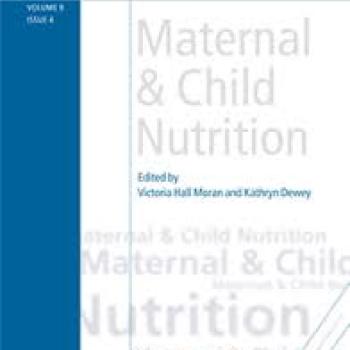Publication Information

Undernutrition is associated with poor cognitive development, late entry into school, decreased years of schooling, reduced productivity, and smaller adult stature. We use longitudinal data from 1674 Peruvian children participating in the Young Lives study to assess the relative impact of early stunting (stunted at 6-18 months of age) and concurrent stunting (stunted at 4.5-6 years of age) on cognitive ability. Anthropometric data were longitudinally collected for children at 6-18 months of age and 4.5-6 years of age at which time verbal and quantitative ability were also assessed. We estimate that an increase in concurrent height-for-age z-scores (HAZ) by one standard deviation was associated with an increase in a child's score on the Peabody Picture Vocabulary Test (PPVT) by 2.35 points (CI: 1.55-3.15) and a 0.16 point increase on the Cognitive Development Assessment (CDA) (CI: 0.05-0.27). Further, we report that the estimate for concurrent HAZ and PPVT is significantly higher than the estimate for early stunting and PPVT. We found no significant difference between early and concurrent estimates for HAZ and CDA. Children from older mothers, children whose mothers had higher education levels, children living in urban areas, children who attended preschool, children with fewer siblings, and children from wealthier backgrounds scored higher on both assessments. Cognitive skills of children entering school were associated with early stunting but the strongest association was found with concurrent stunting suggesting that interventions preventing linear growth faltering should not only focus on the under twos but include children up to five years of age.
Keywords: stunting, chronic undernutrition, cognitive development, preschool children, Peru
The final published version of the article is available on the journal website.

Undernutrition is associated with poor cognitive development, late entry into school, decreased years of schooling, reduced productivity, and smaller adult stature. We use longitudinal data from 1674 Peruvian children participating in the Young Lives study to assess the relative impact of early stunting (stunted at 6-18 months of age) and concurrent stunting (stunted at 4.5-6 years of age) on cognitive ability. Anthropometric data were longitudinally collected for children at 6-18 months of age and 4.5-6 years of age at which time verbal and quantitative ability were also assessed. We estimate that an increase in concurrent height-for-age z-scores (HAZ) by one standard deviation was associated with an increase in a child's score on the Peabody Picture Vocabulary Test (PPVT) by 2.35 points (CI: 1.55-3.15) and a 0.16 point increase on the Cognitive Development Assessment (CDA) (CI: 0.05-0.27). Further, we report that the estimate for concurrent HAZ and PPVT is significantly higher than the estimate for early stunting and PPVT. We found no significant difference between early and concurrent estimates for HAZ and CDA. Children from older mothers, children whose mothers had higher education levels, children living in urban areas, children who attended preschool, children with fewer siblings, and children from wealthier backgrounds scored higher on both assessments. Cognitive skills of children entering school were associated with early stunting but the strongest association was found with concurrent stunting suggesting that interventions preventing linear growth faltering should not only focus on the under twos but include children up to five years of age.
Keywords: stunting, chronic undernutrition, cognitive development, preschool children, Peru
The final published version of the article is available on the journal website.

